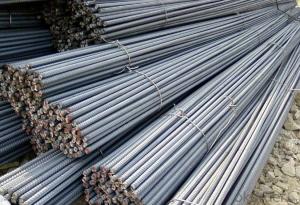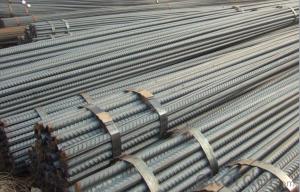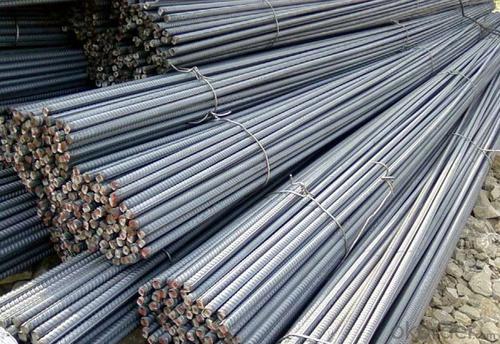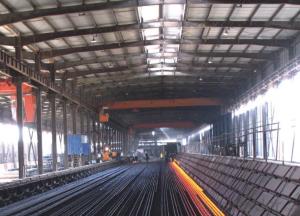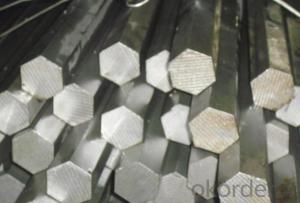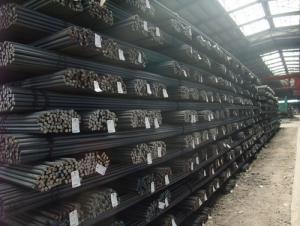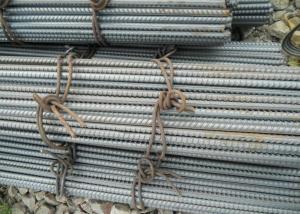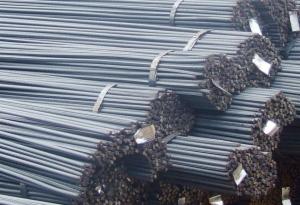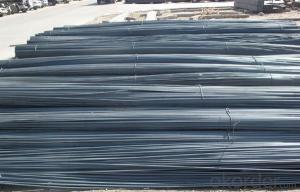Deformed Bar Hot Rolled High Quality BS4449
- Loading Port:
- Tianjin
- Payment Terms:
- TT OR LC
- Min Order Qty:
- 25 m.t.
- Supply Capability:
- 20000000 m.t./month
OKorder Service Pledge
OKorder Financial Service
You Might Also Like
Specification
Product Description:
OKorder is offering high quality Hot Rolled Steel I-Beams at great prices with worldwide shipping. Our supplier is a world-class manufacturer of steel, with our products utilized the world over. OKorder annually supplies products to European, North American and Asian markets. We provide quotations within 24 hours of receiving an inquiry and guarantee competitive prices.
Product Applications:
Deformed bar is widely used in buildings, bridges, roads and other engineering construction. Big to highways, railways, bridges, culverts, tunnels, public facilities such as flood control, dam, small to housing construction, beam, column, wall and the foundation of the plate, deformed bar is an integral structure material. With the development of world economy and the vigorous development of infrastructure construction, real estate, the demand for deformed bar will be larger and larger
Product Advantages:
OKorder's Steel I-Beams are durable, strong, and resist corrosion, exact size, regular package, chemical and mechanical properties are stable.
Main Product Features:
· Premium quality
· Prompt delivery & seaworthy packing (30 days after receiving deposit)
· Corrosion resistance
· Can be recycled and reused
· Mill test certification
· Professional Service
· Competitive pricing
Product Specifications:
Manufacture: Hot rolled
Grade: BS4449
Certificates: ISO, SGS, BV, CIQ
Diameter: 6mm,8mm,10mm,12mm,14mm,16mm,18mm,20mm,
22mm,25mm,28mm,32mm,36mm,40mm,50mm
Length: 6M, 9M,12M or as required
Packaging: Export packing, nude packing, bundled
Chemical Composition: (Please kindly find our chemistry of our material based on HRB500 as below for your information)
Grade | Technical data of the original chemical composition (%) | ||||||
C | Mn | Si | S | P | V | ||
HRB400 | ≤0.25 | ≤1.60 | ≤0.80 | ≤0.045 | ≤0.045 | 0.04-0.12 | |
Physical capability | |||||||
Yield Strength (N/cm²) | Tensile Strength (N/cm²) | Elongation (%) | |||||
≥400 | ≥570 | ≥14 | |||||
Theoretical weight and section area of each diameter as below for your information:
Diameter(mm) | Section area (mm²) | Mass(kg/m) | Weight of 12m bar(kg) |
6 | 28.27 | 0.222 | 2.664 |
8 | 50.27 | 0.395 | 4.74 |
10 | 78.54 | 0.617 | 7.404 |
12 | 113.1 | 0.888 | 10.656 |
14 | 153.9 | 1.21 | 14.52 |
16 | 201.1 | 1.58 | 18.96 |
18 | 254.5 | 2.00 | 24 |
20 | 314.2 | 2.47 | 29.64 |
22 | 380.1 | 2.98 | 35.76 |
25 | 490.9 | 3.85 | 46.2 |
28 | 615.8 | 4.83 | 57.96 |
32 | 804.2 | 6.31 | 75.72 |
36 | 1018 | 7.99 | 98.88 |
40 | 1257 | 9.87 | 118.44 |
50 | 1964 | 15.42 | 185.04 |
FAQ:
Q1: Why buy Materials & Equipment from OKorder.com?
A1: All products offered byOKorder.com are carefully selected from China's most reliable manufacturing enterprises. Through its ISO certifications, OKorder.com adheres to the highest standards and a commitment to supply chain safety and customer satisfaction.
Q2: How do we guarantee the quality of our products?
A2: We have established an advanced quality management system which conducts strict quality tests at every step, from raw materials to the final product. At the same time, we provide extensive follow-up service assurances as required.
Q3: How soon can we receive the product after purchase?
A3: Within three days of placing an order, we will begin production. The specific shipping date is dependent upon international and government factors, but is typically 7 to 10 workdays.
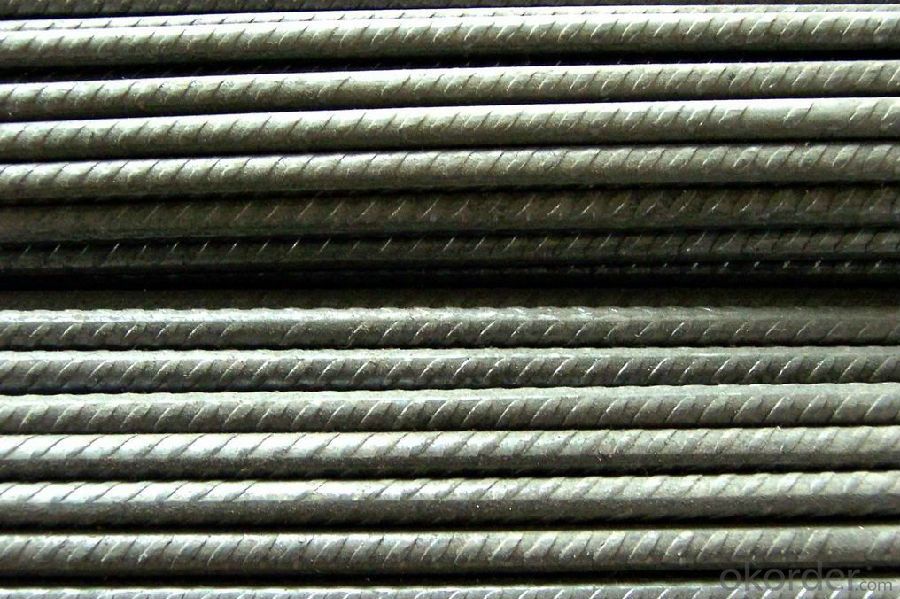

- Q: How do steel rebars contribute to the overall safety of a structure?
- Steel rebars contribute to the overall safety of a structure in several ways. Firstly, they provide reinforcement to concrete, which is a brittle material and prone to cracking under tension. By embedding steel rebars within the concrete, the structure gains enhanced tensile strength, allowing it to withstand greater loads and resist cracking or failure. Secondly, steel rebars help to distribute and dissipate stress throughout the structure. When a load is applied to a structure, such as an earthquake or heavy winds, it creates internal forces that need to be managed and dispersed. Steel rebars act as a network of interconnected bars, transferring the load from one rebar to another, and eventually to the foundation. This helps to prevent localized stress concentrations and ensures that the structure can better withstand external forces. Moreover, steel rebars improve the ductility of a structure. Ductility refers to a material's ability to deform without breaking. When a structure is subjected to extreme forces, such as seismic activity or high winds, it needs to be able to flex and absorb energy without collapsing. Steel rebars provide this ductility by elongating and deforming under stress, absorbing and dissipating energy before reaching a critical point of failure. This characteristic makes steel rebars crucial in protecting the overall integrity of the structure and ensuring the safety of its occupants. Furthermore, steel rebars also contribute to the long-term durability of a structure. Concrete is susceptible to various environmental factors, such as moisture, temperature fluctuations, and chemical exposure, which can lead to deterioration and weakening over time. By reinforcing the concrete with steel rebars, the structure becomes more resistant to these factors and maintains its strength and stability for a longer period. In conclusion, steel rebars play a vital role in ensuring the overall safety of a structure. They enhance the tensile strength of concrete, distribute stress, improve ductility, and increase the durability of the structure. By providing these essential properties, steel rebars greatly reduce the risk of structural failure and protect the lives and well-being of those within the building.
- Q: What is the role of steel rebars in reducing concrete shrinkage?
- Steel rebars play a crucial role in reducing concrete shrinkage by providing reinforcement and controlling cracking. When embedded within the concrete, rebars help distribute stress and prevent the formation of large cracks. This reinforcement enhances the structural integrity of the concrete and minimizes shrinkage, leading to a more durable and stable construction material.
- Q: How do steel rebars prevent cracking in concrete?
- The reinforcement provided by steel rebars is essential in preventing cracking in concrete. By increasing the overall strength and durability of the structure, steel rebars counteract the tensile forces that cause concrete to crack. To create a reinforcing mesh or framework, high-strength steel rebars are strategically placed within the concrete. This mesh acts as a skeleton, effectively absorbing and distributing the tensile forces throughout the structure. As a result, cracks are prevented from forming. When external loads, such as heavy weights or seismic forces, are applied to the concrete, the rebars bear the tensile stress instead of the concrete itself. This is possible because steel rebars have a much higher tensile strength compared to concrete. By distributing stress more evenly, the rebars minimize crack formation and help maintain the concrete's structural integrity. Additionally, steel rebars improve the bond between the concrete and the reinforcement, further preventing cracks. While concrete has excellent compressive strength, its tensile strength is relatively low. The inclusion of rebars increases the overall tensile strength of the concrete, reducing the likelihood of cracking under tension. The bond between the rebars and the concrete creates a composite material that can effectively withstand both compressive and tensile forces. In summary, steel rebars play a crucial role in preventing cracking in concrete. They provide reinforcement, absorb tensile forces, and enhance the overall strength and durability of the structure. By acting as a skeleton within the concrete and distributing stress, they prevent the formation of cracks and ensure the long-lasting stability of the construction.
- Q: What is the difference between the material of steel thread and its use?
- Main uses: widely used in housing, bridges, roads and other civil engineering construction.Main origin: the manufacturer of thread steel is mainly distributed in North China and Northeast China
- Q: What are the guidelines for the proper spacing of steel rebars in beams?
- The guidelines for the proper spacing of steel rebars in beams are determined by engineering standards and codes. These guidelines ensure the structural integrity and strength of the beam. Here are some general guidelines to consider: 1. Rebar spacing: The spacing between rebars should be such that it allows for proper concrete placement and consolidation. Typically, the spacing is measured in terms of rebar diameter or as a percentage of the beam depth. The specific spacing requirements may vary based on factors such as the beam size, load requirements, and design specifications. 2. Minimum and maximum spacing: There are usually minimum and maximum spacing requirements for rebars in beams. The minimum spacing ensures proper concrete cover around the rebar to protect it from corrosion and provide fire resistance. The maximum spacing helps in distributing the loads evenly and prevents excessive cracking of the concrete. 3. Concrete cover: The rebars should be adequately covered by concrete to provide protection against corrosion and provide fire resistance. The concrete cover is the distance between the outer surface of the rebar and the edge of the beam. The required concrete cover is specified in engineering codes and is based on factors such as exposure conditions, durability requirements, and fire ratings. 4. Spacing around supports and openings: Special attention should be given to the spacing of rebars around supports such as columns and walls, as well as around openings like doorways or windows. These areas may experience higher stresses and require additional reinforcement. Engineering codes provide specific requirements for these situations, taking into account the size and shape of the supports or openings. 5. Lateral and longitudinal reinforcement: In addition to the spacing of rebars along the length of the beam (longitudinal reinforcement), beams may require additional reinforcement in the form of stirrups or ties (lateral reinforcement). These elements provide resistance against shear forces and help in preventing diagonal cracking. The spacing and size of these additional reinforcement elements are determined based on the design requirements and load conditions. It is important to note that the specific guidelines for spacing of steel rebars in beams may vary depending on regional building codes, project specifications, and engineering standards. Therefore, it is crucial to consult with a qualified structural engineer or refer to the applicable building codes and design documents for accurate and up-to-date guidelines.
- Q: Can steel rebars be bent or shaped during construction?
- Yes, steel rebars can be bent or shaped during construction. They are commonly used in reinforced concrete structures and can be bent to fit the required design, shape, or structure.
- Q: Does the grade three thread steel with "E" have the same information price as the ordinary three grade thread steel? Is there a big difference?
- As far as I know, the price of information may not be divided into "E" and "E", but there are mandatory requirements on the standard. It is estimated that the price will not be much different.
- Q: Can steel rebars be used in tunneling and mining operations?
- Yes, steel rebars can be used in tunneling and mining operations. Rebars, which are steel bars commonly used to reinforce concrete structures, can also be employed in underground construction projects such as tunnels and mines. These steel bars provide additional strength and stability to the structures in these environments, ensuring durability and safety. In tunneling projects, rebars are often embedded in shotcrete or concrete linings to enhance the structural integrity of the tunnel walls and prevent collapse. Similarly, in mining operations, rebars are used to reinforce the roofs, walls, and support structures within the mine, safeguarding against potential hazards such as rockfalls and cave-ins. The use of steel rebars in tunneling and mining operations is crucial for maintaining the integrity and stability of these underground structures.
- Q: What are the potential risks of using steel rebars in construction?
- One potential risk of using steel rebars in construction is corrosion. If the rebars are not properly protected or if they are exposed to moisture, they can rust over time, leading to structural integrity issues. Another risk is poor quality control during manufacturing, which can result in rebars with defects or inadequate strength. Additionally, if rebars are not installed correctly or if they are not anchored securely, they may fail to provide the necessary reinforcement, compromising the overall stability and safety of the structure.
- Q: What is the process of galvanizing steel rebars?
- Galvanizing steel rebars is a process that involves applying a protective layer of zinc to the surface of the steel rebar to prevent corrosion and extend its lifespan. The process typically involves the following steps: 1. Surface Preparation: The steel rebars are thoroughly cleaned to remove any dirt, oil, or scale on the surface. This is typically done by using a combination of chemical cleaning agents and mechanical methods such as sandblasting or shot blasting. 2. Pickling: After cleaning, the rebars are immersed in a pickling solution, usually a mixture of hydrochloric acid and water. This solution removes any remaining impurities or oxides from the surface of the rebars. 3. Fluxing: The pickled rebars are then rinsed to remove any residual acid and are immersed in a flux solution. The flux solution helps to remove any remaining oxides and ensures proper adhesion of the zinc coating. 4. Galvanizing: The fluxed rebars are then dipped into a bath of molten zinc. The temperature of the zinc bath is typically maintained between 815 to 850 degrees Fahrenheit (435 to 455 degrees Celsius). The rebars are carefully immersed and then slowly withdrawn to allow excess zinc to drain off. 5. Quenching: After galvanizing, the rebars may be quenched in a specialized solution to cool them rapidly and stabilize the zinc coating. This step helps to prevent the formation of excessive zinc oxide on the surface. 6. Inspection: Once the galvanized rebars have cooled, they undergo a thorough inspection to ensure the quality of the coating. Visual inspection, thickness measurement, and adhesion tests are commonly conducted to assess the zinc coating's integrity. Overall, the galvanizing process provides a durable and effective protective coating for steel rebars, making them resistant to corrosion and extending their lifespan in various applications such as construction, reinforcement, and infrastructure projects.
Send your message to us
Deformed Bar Hot Rolled High Quality BS4449
- Loading Port:
- Tianjin
- Payment Terms:
- TT OR LC
- Min Order Qty:
- 25 m.t.
- Supply Capability:
- 20000000 m.t./month
OKorder Service Pledge
OKorder Financial Service
Similar products
Hot products
Hot Searches
Related keywords
